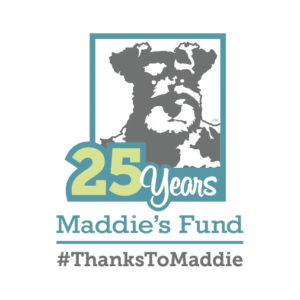As our 25th anniversary celebration continues, we’re looking back “then and now” style at some of the grants we’ve given over the years, and the amazing impact they’ve had on their communities since then.
In 2006, after a couple of false starts, the Animal Shelter Alliance of Portland (ASAP) was formed. The coalition, comprised of six shelters, serves the greater Portland, Oregon and Vancouver, Washington metropolitan areas. They currently have a combined live release rate of 95.2%.
ASAP received the Maddie’s® Lifesaving Award in 2013, which was only made possible by the community “coming together by tracking and reporting shelter statistics and by holding all agencies accountable,” said Anika Moje, manager of ASAP.
Thanks to an earlier grant from Maddie’s Fund®, ASAP was able to review their data and learned that 80% of animals euthanized in shelters were cats. It was clear they needed to focus their lifesaving efforts on cats. Their Spay & Save program has completed more than 90,000 surgeries for low-income families. Their cat intake has declined by 50% and their live release rate increased from 49% in 2006 to 95% in 2018.
Moje stressed the importance of data collection. “Having good data allowed us to monitor our success both at the individual shelter level and as a coalition,” she said. “[It’s] helped the coalition focus on measurable results in our programs and initiatives.” In 2008 the coalition began collecting and reporting shelter data according to the Asilomar Accords and established a Pet Evaluation Matrix (PEM) that included input from the animal welfare community, the veterinary community and the general public.
Maddie’s Fund awarded ASAP the Lifesaving Award in 2013 after they had achieved and maintained their adoption guarantee for all healthy pets entering the shelter for two years . The Lifesaving Award was distributed to each of the six ASAP sheltering organizations which set the stage to get to the live release rate of 95.2% and to expand the adoption guarantee to treatable pets. Coalition members were able to grow several programs which contributed to an increase in lives saved. Programs like increasing transfers, providing high-quality medical care, hiring a dog behaviorist and continuing education opportunities for staff.
These improvements have made Moje think about where animal welfare is headed in the future. Thanks to the success of spay/neuter efforts, intake has declined significantly but the animals in their care have a much higher rate of medical and behavioral problems. “Shelters have had to become experts in veterinary care and behavioral rehabilitation – and in a relatively short time period,” she explained. “In addition, we have had to focus more resources on pre- and post-adoption counseling and support.”
She’s also concerned that puppy mills will step in to meet the demand for dogs and cats in their area. Adoption is more popular than ever she says, and transport can’t be relied on as the solution. “There is not an easy answer to this, but we think it is a critical issue that the animal welfare industry needs to address,” Moje said.
She also hopes that people will use the shelter as a resource when they have an issue with their pets, rather than it be the place they go to surrender their pets.
Moje is encouraged by what she sees as less judgment from the animal welfare field – the mentality of “us versus them” has lessened, and there’s been a greater focus on helping pet owners provide better care rather than criticizing and punishment.
We’re proud of the great strides ASAP has made and look forward to what they do in the future.

